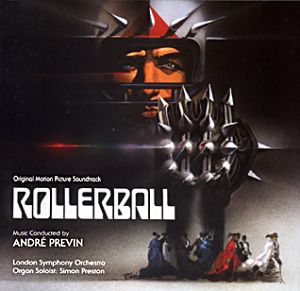André PREVIN/various classical composers
Rollerball
Andre Previn conducting the London Symphony Orchestra
Varèse Sarabande VSD-6354 [38.21]

- Bach: Toccata In D Minor (Simon Preston, organ)
- Shostakovitch: Symphony No. 8 (extract from 1st movement)
- Previn: Glass Sculpture
- Previn: Executive Party
- Shostakovitch: Symphony No. 5 (extract from 3rd movement)
- Albinoni: Adagio (violin solo: John Brown)
- Tchaikovsky: Sleeping Beauty Waltz
- Previn: Executive Party Dance
- Shostakovitch: Symphony No. 5 (extract from 4th movement)
Coinciding with the Special Edition DVD release of the greatest film Stanley Kubrick never made comes this first ever CD issue of the original Rollerball LP soundtrack (not to be confused with the soundtrack to the appalling remake with music by Eric Serra). Musically the album is exactly the same as the LP, featuring three cues by André Previn and six classical selections or extracts.
Rollerball was made in 1974-5 towards the end of the cycle of serious SF films launched by 2001: A Space Odyssey (1968) and before Star Wars (1977) redirected the genre to retro-action adventure. Thematically and stylistically Rollerball could form the third part of a trilogy with 2001 and Kubrick's A Clockwork Orange (1971), and in keeping with those films its soundtrack comprised almost entirely classical music, following the model of the latter by incorporating a little electronics. At the time André Previn was the Principle Conductor of the London Symphony Orchestra and his work on Rollerball more or less brought to a close his long standing involvement in film music. His three cues comprise two "source" tracks for the "Executive Party" scene, and despite the film being set sometime in the not too distant future the cues are locked completely in their decade, being solid examples of jazz-funk-rock. Almost all attempts to write "futuristic" music soon sound dated, and these are no exception. Previn's third cue is a short electronic mood piece called "Glass Sculpture" and has little substance.
In exactly the same way 2001: A Space Odyssey begins and ends with the opening of Richard Strauss' Also Sprach Zarathustra, Rollerball begins and ends with the opening of JS Bach's Toccata and Fugue in D minor. Specially recorded for the film, as were all the pieces on this disc, we are presented only with the stirring first three minutes and the music is not reprised at the conclusion of the album. Instead the disc ends with an extract from the fourth movement of Shostakovitch's Symphony No.5, where the bold timpani evoke associations, conscious or otherwise, of Zarathustra. This is complimented by two more Shostakovitch extracts, and though staying in Russia, rather jarringly by a waltz from Tchaikovsky's Nutcracker ballet. After the Bach the music most people will remember from the film is "Albinoni's Adagio", the haunting melody used as a love theme to express James Caan's character's hopeless love for his estranged wife.
Away from the screen this makes an odd collection, so much so that apart from as a memento of a memorable film it is hard to imagine who would want to listen to these pieces together. As a bonus the booklet reproduces five full colour examples of film artist Bob Peak's original Rollerball paintings. Its nice to see them, but makes one wish they had been included with the LP so they could have been appreciated at a better size.
Gary S Dalkin
- as a souvenir of the film;
- as an album
Return to Index